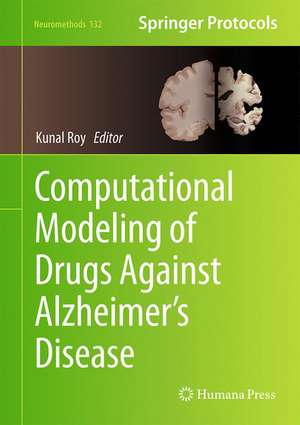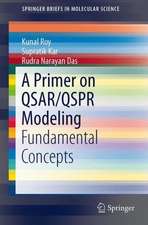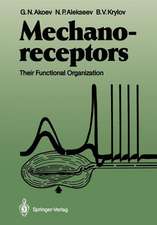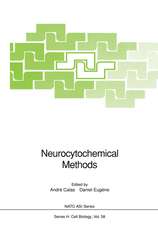Computational Modeling of Drugs Against Alzheimer’s Disease: Neuromethods, cartea 132
Editat de Kunal Royen Limba Engleză Hardback – 29 sep 2017
Cutting-edge and authoritative, Computational Modeling of Drugs Against Alzheimer’s Disease is a valuable resource for learningabout the latest computational techniques used to study this disease.
| Toate formatele și edițiile | Preț | Express |
|---|---|---|
| Paperback (2) | 617.74 lei 38-45 zile | |
| Springer – 10 aug 2018 | 617.74 lei 38-45 zile | |
| Springer Us – 30 iun 2023 | 1116.17 lei 38-45 zile | |
| Hardback (2) | 977.17 lei 6-8 săpt. | |
| Springer – 29 sep 2017 | 977.17 lei 6-8 săpt. | |
| Springer Us – iul 2023 | 1839.50 lei 6-8 săpt. |
Din seria Neuromethods
- 5%
 Preț: 347.58 lei
Preț: 347.58 lei - 15%
 Preț: 659.53 lei
Preț: 659.53 lei - 15%
 Preț: 665.08 lei
Preț: 665.08 lei - 18%
 Preț: 986.63 lei
Preț: 986.63 lei - 18%
 Preț: 953.03 lei
Preț: 953.03 lei - 18%
 Preț: 955.25 lei
Preț: 955.25 lei - 20%
 Preț: 1129.39 lei
Preț: 1129.39 lei - 20%
 Preț: 1252.07 lei
Preț: 1252.07 lei - 18%
 Preț: 1291.45 lei
Preț: 1291.45 lei - 15%
 Preț: 652.31 lei
Preț: 652.31 lei - 18%
 Preț: 955.70 lei
Preț: 955.70 lei - 23%
 Preț: 705.40 lei
Preț: 705.40 lei - 18%
 Preț: 973.38 lei
Preț: 973.38 lei - 18%
 Preț: 964.86 lei
Preț: 964.86 lei - 18%
 Preț: 968.03 lei
Preț: 968.03 lei - 15%
 Preț: 662.95 lei
Preț: 662.95 lei - 15%
 Preț: 646.43 lei
Preț: 646.43 lei - 15%
 Preț: 649.71 lei
Preț: 649.71 lei -
 Preț: 395.29 lei
Preț: 395.29 lei - 19%
 Preț: 580.68 lei
Preț: 580.68 lei - 19%
 Preț: 584.13 lei
Preț: 584.13 lei - 19%
 Preț: 566.41 lei
Preț: 566.41 lei - 15%
 Preț: 652.17 lei
Preț: 652.17 lei - 15%
 Preț: 655.13 lei
Preț: 655.13 lei - 18%
 Preț: 1009.58 lei
Preț: 1009.58 lei - 18%
 Preț: 959.36 lei
Preț: 959.36 lei - 15%
 Preț: 652.49 lei
Preț: 652.49 lei - 15%
 Preț: 649.54 lei
Preț: 649.54 lei - 15%
 Preț: 649.87 lei
Preț: 649.87 lei - 15%
 Preț: 650.19 lei
Preț: 650.19 lei - 15%
 Preț: 648.42 lei
Preț: 648.42 lei - 18%
 Preț: 1039.22 lei
Preț: 1039.22 lei - 18%
 Preț: 963.15 lei
Preț: 963.15 lei
Preț: 977.17 lei
Preț vechi: 1191.68 lei
-18% Nou
Puncte Express: 1466
Preț estimativ în valută:
186.99€ • 199.95$ • 155.90£
186.99€ • 199.95$ • 155.90£
Carte tipărită la comandă
Livrare economică 18 aprilie-02 mai
Preluare comenzi: 021 569.72.76
Specificații
ISBN-13: 9781493974030
ISBN-10: 1493974033
Pagini: 645
Ilustrații: XVII, 645 p. 222 illus., 158 illus. in color.
Dimensiuni: 178 x 254 x 42 mm
Greutate: 1.36 kg
Ediția:1st ed. 2018
Editura: Springer
Colecția Humana
Seria Neuromethods
Locul publicării:New York, NY, United States
ISBN-10: 1493974033
Pagini: 645
Ilustrații: XVII, 645 p. 222 illus., 158 illus. in color.
Dimensiuni: 178 x 254 x 42 mm
Greutate: 1.36 kg
Ediția:1st ed. 2018
Editura: Springer
Colecția Humana
Seria Neuromethods
Locul publicării:New York, NY, United States
Cuprins
Alzheimer’s Disease Therapy: Present and Future Molecules.- Recent Advances in Computational Approaches for Designing Potential Anti-Alzheimer’s Agents.- Computer-Aided Drug Design Approaches to Study Key Therapeutic Targets in Alzheimer’s Disease.- Virtual Screening in the Search of New and Potent Anti-Alzheimer Agents.- Molecular Field Topology Analysis (MFTA) in the Design of Neuroprotective Compounds.- Galantamine Derivatives as Acetylcholinesterase Inhibitors: Docking, Design, Synthesis, and Inhibitory Activity.- Modeling of BACE-1 Inhibitors as Anti-Alzheimer’s Agents.- Design of Anti-Alzheimer’s Disease Agents Focusing on a Specific Interaction with Target Biomolecules.- Molecular Docking and Molecular Dynamics Simulation to Evaluate Compounds that Avoid the Amyloid Beta 1-42 Aggregation.- In Silico Strategies to Design Small Molecules to Study Beta-Amyloid Aggregation.- Computational Approaches to Understand Cleavage Mechanism of Amyloid Beta (Aβ) Peptide.- Computational Modeling of Gamma-Secretase Inhibitors as Anti-Alzheimer Agents.- Molecular Modeling of Tau Proline-Directed Protein Kinase (PDPK) Inhibitors.- Computational Modeling of Kinase Inhibitors as Anti-Alzheimer Agents.- Computational Modeling of Drugs for Alzheimer's Disease: Design of Serotonin 5-HT6 Antagonists.- Computational Modeling of Diagnostic Imaging Agents for Alzheimer's Disease: Molecular Imaging Agents for the In Vivo Detection of Amyloid Plaques in Alzheimer’s Disease.- Computational Approaches for Therapeutic Application of Natural Products in Alzheimer’s Disease.- In Silico Studies Applied to Natural Products with Potential Activity against Alzheimer’s Disease.- Computational Modeling of Multi-Target Directed Inhibitors against Alzheimer's Disease.- Neuropharmacology in Flux: Molecular Modeling Tools for Understanding Protein Conformational Shifts in Alzheimer’s Disease and Related Disorders.- Computational Nanotechnology: A Tool for Screening Therapeutic Nanomaterials against Alzheimer's Disease.
Notă biografică
Dr. Kunal Roy is a Professor in the Department of Pharmaceutical Technology, Jadavpur University, Kolkata, India. He has been a recipient of Commonwealth Academic Staff Fellowship (University of Manchester, 2007) and Marie Curie International Fellowship (University of Manchester, 2013). The field of his research interest is QSAR and Molecular Modeling with application in Drug Design and Ectoxicological Modeling. Dr. Roy has published more than 250 research papers in refereed journals (current SCOPUS h index 35). He has also coauthored two QSAR related books, edited two QSAR books and published ten book chapters. Dr. Roy serves in different capacities in the Editorial Boards of several International Journals.
Textul de pe ultima copertă
This volume describes different computational methods encompassing ligand-based approaches (QSAR, pharmcophore), structure-based approaches (homology modeling, docking, molecular dynamics simulation), and combined approaches (virtual screening) with applications in anti-Alzheimer drug design. Different background topics like molecular etiologies of Alzheimer’s disease, targets for new drug development, and different cheminformatic modeling strategies are covered for completeness. Special topics like multi-target drug development, natural products, protein misfolding, and nanomaterials are also included in connection with computational modeling of anti-Alzheimer drug development. In Neuromethods series style, chapters include the kind of detail and key advice from the specialists needed to get successful results in your laboratory.
Cutting-edge and authoritative, Computational Modeling of Drugs Against Alzheimer’s Disease is a valuableresource for learning about the latest computational techniques used to study this disease.
Caracteristici
Includes cutting-edge methods and protocols Provides step-by-step detail essential for reproducible results Contains key notes and implementation advice from the experts




























